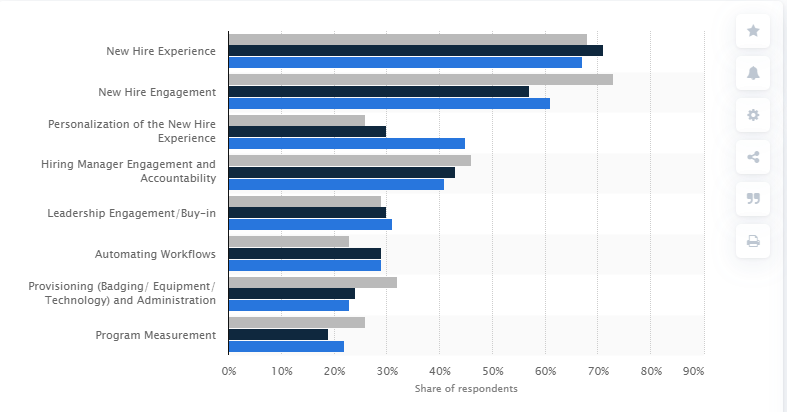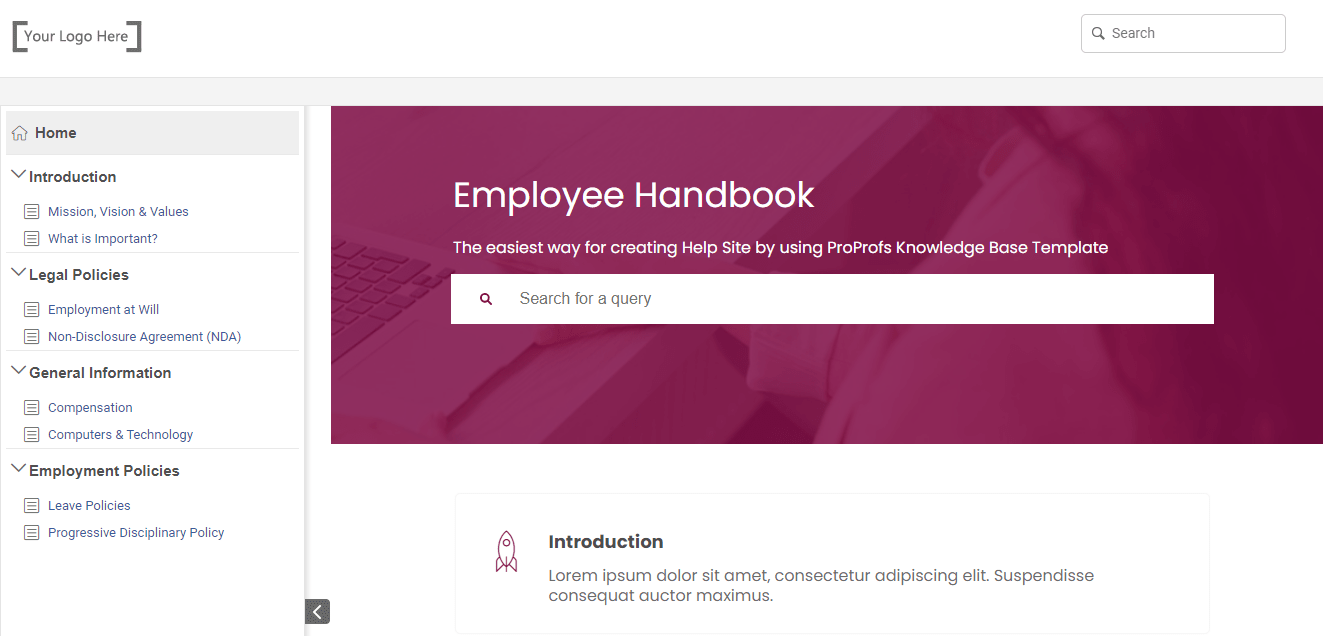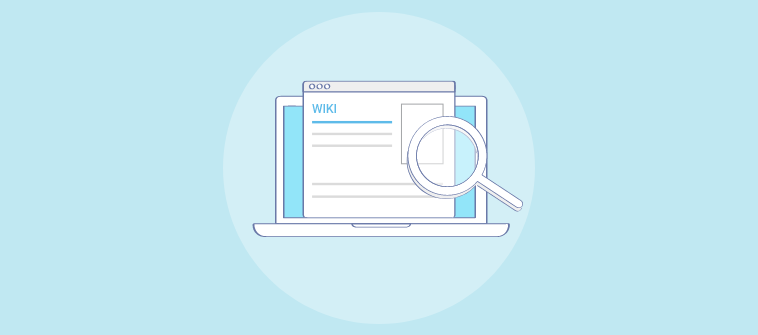Did you ever imagine walking into the office on your first day at work and getting to know the key players from your team over doughnuts and coffee?
Well, that’s how the onboarding program at Zumper goes. Google leads the way when it comes to innovative onboarding programs and naturally excels at making employees feel welcome right from the moment they walk into your office on their first day at work.
LinkedIn queues up a series of icebreaker meetings and lunch with the team for new hires. In fact, their onboarding program is one of the most anticipated ones for new employees, and rightly so.
Gone are those days when you walked into a new office with trepidation ringing in your very soul, only to be faced with a grim HR sternly laying out the rules and escorting you to your workstation.
Employers worldwide are playing around with yesteryear’s work structure before the likes of Google and Facebook revolutionized traditional offices with nap pods and engineering boot camps.
If you are a modern-day employer, the time has come for you to restructure the ways, you onboard employees. This post will walk you through the essentials of onboarding, with special emphasis on the effectiveness of a knowledge base in the same.
What Is Employee Onboarding?
Employee onboarding is an essential process that brings new hires up to speed quickly. Finding and hiring new employees is challenging, but onboarding and retaining them is a different ball game altogether.
Effective onboarding ensures that nothing falls through the cracks and new hires get a warm welcome and a healthy, supportive, and growth-focused environment right from day one.
With smooth onboarding, the first few weeks of new hires pass without a hitch. As they feel comfortable at the workplace, it doesn’t take them much time to become fully productive.
There is a popular perception that onboarding is administrative in nature. But, in reality, it is way more than that. It includes processes to align new employees to your companies’ culture, goals, and work dynamics. It aims to make them feel an integral part of your organization and paves the way for peak performance.
Effective Employee Onboarding Is a Business Imperative. Here’s Why
Okay, so what is the big deal about employee onboarding anyway?
Studies show that companies with a functional onboarding system retain 81% of new hires. Also, 73% of new employees want a comprehensive review of the company policies within the first seven days of joining an organization. So, if you are planning to hire new employees, ensure that you walk them through all essential information.
Here are a few benefits that will urge you to think about implementing a full-fledged onboarding system right from this business quarter.
1. Sets up a Welcoming Work Atmosphere
Massive paperwork and computer or laptop issues can be ruled out completely when you have a structured onboarding program. It provides a positive and welcoming atmosphere for new hires, so they feel at home right from day one.
The quality of onboarding decides whether new hires will stick to your organization or walk away after the initial few weeks or months. The more streamlined the process, the better your company will absorb new employees into its culture.
2. Improves Employee Retention Level
Onboarding programs are directly related to higher employee retention rates the world over. If you want to retain your workforce for long, create a compelling onboarding program that makes employees feel that they truly belong to your company. They should not feel out of place and uncomfortable. Feelings of discomfort can cause your employees to stay dissatisfied, unproductive and eventually leave your organization in a short period. An effective onboarding process provides a warm welcome, healthy atmosphere, and necessary guidance to your new hires.
3. Enhances Productivity
Organizations with a robust onboarding program are 50% more likely to enhance employee productivity. Imagine an employee joins your company and is clueless about your policies, roles, responsibilities, clients, projects, etc.
It requires a great deal of hard work to get acquainted with essential company information. This might take days or even weeks. With proper onboarding, new hires have everything they need at their fingertips. They don’t have to go from pillar to post, figuring out what they are supposed to do or how they can apply for a leave.
This means less time goes into unnecessary things, and more time can be invested in real work.
4. Seamless Employee Experience
Poor experiences can lead to employees leaving your organization for something better. For talented employees, there are always good opportunities in the market. If you don’t value their talent, someone else will.
Excellent onboarding experience sets the tone for employees’ entire journey in your company. If the initial few days and weeks are full of hassles, how can the rest of the journey be free of hitches?
Proper onboarding helps new hires blend into your company’s culture, introduces them to your work processes, and reassures them that they are at the right place. Focusing on these aspects beyond the onboarding period improves the overall employee experience right from the time they join till they leave your company.
Read More: How to Build an Employee Self-Service Portal – Tips & Tricks
How Can Solid Onboarding Boost Your Business Growth?
Employee onboarding is essential to transform new hires into productive resources. A well-managed onboarding gets your new employees:
- Up to speed faster
- Integrated with your work culture
- Aligned with your company’s goals, mission, and vision
All these things combined turn them into incredible assets, ready to drive your business forward. Imagine when good onboarding leads to excellent performance and higher productivity.
What happens next? It results in a positive growth graph.
In fact, statistics show that strong employee onboarding can lead to a 60% yearly improvement in revenue and a 63% boost in customer satisfaction.
This speaks volumes about why effective employee onboarding is a business imperative.
A strong team of employees who have received a good onboarding experience will be better positioned to achieve your business goals and contribute to your overall success.
But, wait. What exactly does the best-in-class onboarding look like?
Read on to find out.
What Are the Characteristics of a Successful Employee Onboarding?
Just showing your employees around and giving them a well-functioning laptop to work cannot be called onboarding. It is a lot more than these basic things.
To deliver an exemplary onboarding experience, you first need to know the characteristics of effective onboarding.
This section shows what successful onboarding looks like.
1. Streamlined & Proactive
It is a common practice for managers to take an informal approach to onboard. They try to set them up on the first day and then forget to check in on them later, assuming that they will figure out things on their own.
This can be the root cause of employee disengagement right from the start.
Effective onboarding is more systematic, proactive, and formal. It defines the roles and responsibilities of new hires, gives them the necessary resources and guidance they need to give their best at work.
Another important thing to note is the time when onboarding begins.
Unlike popular belief that it starts on the first day of office, onboarding begins when you roll out the offer letter. This is the right time to give introductory information about the company and the new roles for which they are hired.
Use this time to set the right first impression about your organization and let it work its magic as the new hires join the workplace.
2. Comprehensive & Relevant
Did you know that experience, engagement, and personalization are some of the top obstacles for onboarding programs?

A successful employee onboarding program is comprehensive, relevant, and personalized for employees across all levels and departments.
It has a clear agenda for the initial period that includes training sessions, introductory meetings with the team, sessions with higher management, and more.
A comprehensive onboarding ensures that nothing falls through the cracks, with employees having access to everything they need to blend well in your organization. They even have access to other employees’ work experiences in the company to give them an idea of the work culture and the values you stand for.
New hires can communicate with peers and listen to their stories. This gives them first-hand knowledge of their experiences, helping new employees analyze how well they fit in.
3. Phased
Onboarding is not about bombarding new hires with information that’s difficult to digest on the first day itself. Dealing with a new environment and new faces is already a daunting challenge. On top of that, too much information can add to the pressure.
A solid onboarding program doesn’t overwhelm new hires. Instead, it provides a good starting point, making the journey as smooth as possible. It is done in a phased manner, wherein employees can learn at their convenience and get familiar with the work culture in a reasonable amount of time.
On the contrary, if onboarding is done in a rush, it can result in information overload, burnout, and stress right from the beginning.
4. Digital
We all are familiar with first-day job jitters. The feeling of unfamiliarity with everything around you is a little too much to handle.
Digital onboarding solves this problem. It equips employees with convenience by giving them 24×7 access to training materials. This means they can learn, absorb, and grow at their own pace.
Unlike traditional onboarding that demands employees to be physically present in a room, digital onboarding is way more convenient. Employees don’t have to spend long hours or days in training sessions and get frustrated with information overload.
With digital onboarding, they can learn on-the-job and on-the-go. It is cost-effective and, most importantly, requires little to no paperwork.
Read More: Employee Remote Onboarding Checklist
ProProfs Knowledge Base offers the best way to help you deliver a seamless digital onboarding experience to your employees. It helps you build an employee handbook that assists employees at every step from day one of their joining.
Pick a suitable employee handbook template and get started right away-

This was all about how excellent onboarding looks like. It’s now time to delve into the details of the process.
Employee Onboarding Process
Unlike orientation, onboarding starts right from when employees are hired until they completely get absorbed into the company culture. While orientation gives broad training and guides employees on the surface, onboarding dives into the daily details, giving employees a smooth work experience.
Let’s look at the onboarding process steps in detail –
✅ Before Employees’ First Day in Office
To ensure that new hires start their first day on a positive note, you need to be prepared in advance. Here are a few things that you should check before new employees join your office.
- Share important documents like legal documents, employee handbooks, and other resources you want them to have a look at.
- Set up the laptop or computer system that you are going to allot to the new hires
- Keep the team informed about the new employee – name, role, and designation. Ask your team to be friendly and supportive to the new hire in every way possible.
- Schedule meetings with managers and department heads. This will help them plan work in advance and take out some time in their busy day to meet and greet the new employees.
✅ On the First Day
The day has come when your family is going to expand, and like every company, you would want the experience of new hires to be beyond perfect. For a smooth experience on the first day, you should:
- Assign a buddy for the new member of your company. This is essential to ensure that the new employee doesn’t feel out of place.
A buddy is someone who introduces the new member to everyone, makes him feel at ease, and gives an inside view of what working in your office is like. - Take them on the office tour. Show them where your meeting rooms, lunch area, and restrooms are located. Also, show them where different departments are located and ensure that they meet the key people from each department.
- Discuss with new hires what the coming week will be like. Let them ask whatever questions they have and leave no scope of confusion or misunderstanding.
Zappos has done a great job at building a beautiful culture book for its new hires. It offers an inside view of Zappos’ vision and mission, employee reviews, and much more.

✅ On the First Week
This is a crucial time in the onboarding process. This is that stage when you don’t want employees to get overwhelmed and walk away feeling that they are a misfit.
While hiring, employees have to put their best foot forward to get selected. It’s your time now to show your best side.
For a smooth first week, you should:
- Introduce new hires to your company’s culture, values, vision, and mission. Explain to them the kind of behavior and conduct you expect from employees and give them a clear picture of your work environment.
- Guide them through your work processes and procedures and get them up to speed faster. Make them familiar with the tools they will be using daily, and best practices followed within the organization.
- Make new employees feel that they are an integral part of the team. Ask questions and get to know them better. The new hires might be hesitant and nervous or super confident in their first week. Regardless of which is the case, your team should take the initiative to take them for lunch or regular breaks so that they open up and feel a part of your organization.
✅ One to Three Months
This is the stage when you need to dive deep into the onboarding process, focus on employees’ development and help them give their best shot at work.
In this stage, new hires are no more new. They are at a point when they are adept with the basics but need the right push to blend completely in your company.
When new hires a month old, ensure that:
- You have open communication with them. After a month, employees are settled in the office to some extent. It’s a good time to start a dialogue around how their experience has been till now. Ask them what’s going well and what’s distracting them at work.
- Take steps to increase involvement. Foster engagement by asking employees to partake in celebrations, events, and other office activities.
- Start the feedback process. It’s time to give necessary feedback and guide them in the right direction. Constructive feedback from the very beginning turns them into efficient resources in less time.
- Set SMART goals to give employees a channel to make the most of their time and energy. Setting specific goals lays down a proper path for employees to walk on.
- Review their first performance. After a period of three months, employees should be well-versed with the role. This is an ideal time to analyze their strengths and weaknesses. Give them a transparent review and help them make meaningful improvements to get better at their roles.
A structured onboarding process ensures that nothing slips through the cracks. Employees get the guidance and every other resource they need to become acclimated to the new work environment.
Doing these simple things right can boost onboarding, increase employee happiness and retention.
But, there is something else you must focus on during the onboarding process. Employees should be equipped with the right tools. We all know that digital has brought a new, better, and more convenient way of learning and training.
That’s precisely why an online, 24×7 accessible tool is a must-have for painless employee onboarding. For example, a cloud-based knowledge base is an excellent option for seamless onboarding. Let’s learn how.
Online Knowledge Base: Your Go-to Onboarding Tool
Did you know that organizations spend around $3000 on average to onboard every new employee?
Onboarding can cost exorbitantly and affect your balance sheet.
Employee onboarding with an internal knowledge base can fix this and many other issues. Here’s how.
1. Makes Information Readily Available
A knowledge base centralizes crucial company information like policies, work processes, department, and role-specific details, and much more. This pushes many orientation duties out of your way.
Reduced shoulder taps, emails, and calls are just some of the benefits of a knowledge base. The onboarding process using a knowledge base is aimed at making the entire initiation process a lot smoother. That’s exactly what happens when new hires receive essential information, all in one place.
While they can approach colleagues for critical issues and solve basic problems arising during work on their own. A knowledge base turns employees independent from day one.
2. Fosters Self-Paced Learning
With employee training documentation, onboarding is not confined to the office premises. With a digital knowledge base, employees can read essential documents like non-disclosure or non-compete when they are on their way to work or just lazing in bed on a Sunday.
They can go through your company policies in detail when free and save their work time in the office. Besides, learning and training become more convenient with a 24×7 accessible knowledge base. They can learn anytime, anywhere, and from any device in or outside the office.
With elaborate documents out of the way, they can focus more on their tasks when in the office.
3. Promote Collaboration in Your Organization
If you are at a managerial post in a company, you would know it is imperative to get employees collaborating for day-to-day tasks to ensure optimum productivity. Collaborative working should come from the start so that employees get accustomed to it soon. That’s where a knowledge base can be useful.
While old employees can keep updating the knowledge base, new hires can use that knowledge to work better. Once they turn two or three months old, they can start contributing to the online knowledge hub. You can assign new hires the role of a contributor or editor, depending on their strengths.
Allow them to participate in the content creation process and bring their experiences, knowledge, and expertise to the table for everyone to use.
Watch this short video to learn more about collaboration using a knowledge base.
4. Reduces Errors
Miscommunication issues – especially the ones regarding vital company policies, ethics, and other matters – often give rise to complicated workplace problems. A knowledge base-centered onboarding program reduces the chances of such errors, as the information goes through a strict review process before getting published.
Editors regularly review the data, vet it for any errors, and publish it only after it’s approved. This means employees get the most updated, error-free data. Zero errors in the knowledge base content leads to zero errors when accomplishing tasks in real.
5. Takes Employee Training to the Next Level
Employee training constitutes a vital part of the onboarding process, for it lets you tap into the potential of a new hire. Offline training for new employees of different departments can be time-consuming and even wallet-smashing.
You cannot shell out money every month for onboarding employees, especially if you are a startup or mid-level company. An online knowledge base software removes all barriers to learning and training. New hires can learn at their own pace and get familiar with their roles and responsibilities in a reasonable amount of time.
Besides, you cannot expect employees to remember all company information just after a few months of joining. An online information resource provides employees with the right information at their fingertips, ensuring that no task, project, or work gets delayed.
Sterling Gold Mining Corporation’s employee handbook for onboarding and training is Goals. It’s beautifully created and covers everything that employees need to put their best foot forward at work.
6. Shoots Up Productivity & Confidence
You don’t want new hires to go from pillar to post for anything, right? If that happens, it would only lead to wasted time and lost productivity.
As knowledge sharing is an essential aspect of a knowledge base, it saves employees from approaching people now and then for simple matters. For any issue or any question, employees have a knowledge base to find instant answers.
A knowledge base provides constant support to new hires, making them more productive and confident from the start. Employees take less time to understand their roles and the work processes and start giving more time to work that really matters.
All these benefits combined can turn your employee onboarding from mediocre to miraculous.
New Employee Onboarding Checklist to Perfect the Process
Like every company, you would want to give an exemplary joining experience to new hires and set the right first impression. While you carry out the process immaculately, it’s also crucial to remember a few key things that can save you from any possible errors.
Follow this employee onboarding checklist to deliver a seamless experience –
✔️ Create an employee handbook. Your employee handbook content should comprise all company information, including policies, work processes, vision, and mission.
✔️ Make new hires meet with the key people in your organization
✔️ Arrange an informal meet and greet session with the team
✔️ Make their first day and week memorable. Do not overwhelm them with a lot of work right away. Let it be a gradual process.
✔️ Create a customized onboarding program for employees belonging to different teams.
✔️ Assign a buddy who has worked in your organization at least for over a year. Let new hires shadow him or her for some time to gain the first-hand experience of daily work.
✔️ Follow up with new employees after every one or two weeks. Stay updated on how things are progressing at their end.
Following these guidelines to successful onboarding leads to a seamless employee experience from the initial days.
Transform New Hires Into Productive Resources With Solid Onboarding
Google does it, and so do Facebook, Pinterest, Zappos, and Quora.
So why fall behind? A successful onboarding program is one where employees feel that they matter to your organization as much as you matter to them. It lays a strong foundation for new hires to be at their productive best and contribute to your success.
When done right, onboarding can get new hires up to speed quickly, retain the best talent, and boost your business growth.
As discussed above, a knowledge base can prove to be an invaluable asset for your onboarding program. It helps employees learn at their own pace, get instant access to critical information, and be their productive best at work.
FREE. All Features. FOREVER!
Try our Forever FREE account with all premium features!







